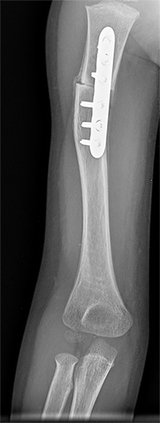Brachial Plexus Birth Palsy, Tendon Transfers and Humeral Osteotomy: Cruz's Story
Brachial Plexus Birth Palsy, Tendon Transfers and Humeral Osteotomy: Cruz's Story
At 3½ years old Cruz had been through a lot. He sustained an injury to the nerves in his neck (brachial plexus) at birth. After years of occupational therapy and two complex operations at Children’s Hospital of Philadelphia to repair the damage, it was time to see if their efforts had paid off.

“When they cut the cast off and he moved his arm for the first time, we all cried,” says Jamie Palm, Cruz’s mom. “That was our breakthrough.”
“Now his arm is almost 100 percent,” she adds. “He can feed himself with his right arm. He can put his own clothes on. All the little thing that people take for granted every day, he couldn’t do. But now he can.”
Problem at birth
Cruz’s medical issues began during delivery when he became stuck in the birth canal. His shoulder was stuck underneath his mom’s pelvic bone, and there was a stretch injury to his neck during the delivery.
Doctors knew right away that something was wrong, and asked pediatricians from Children’s Hospital of Philadelphia (CHOP) to assess the infant. CHOP collaborates with Virtua to provide the most advanced newborn and infant care to families in South Jersey.
Anthony F. Napoli, MD, and Jeffrey S. Fendrick, MD, attending physicians at CHOP Primary Care, Gibbsboro, New Jersey, examined Cruz and confirmed the brachial plexus injury. The brachial plexus is a network of nerves that run from the cervical spinal cord in the neck to the shoulder, arm, and hand. An injury to one or more of these nerves can result in varying degrees of upper extremity weakness or paralysis and numbness.
They recommended he begin occupational therapy as soon as possible. At 11 days old, Cruz began weekly therapy sessions to stretch his right arm and encourage him to use his arm as much as possible.
As Cruz grew, the doctors continued to evaluate him. After further testing and ongoing monitoring, they discovered the boy’s right deltoid muscle (which covers the outside of the shoulder) wasn’t working properly. Although his brain sent signals to the deltoid muscle to move, the messages were not received. Essentially, the muscle was just not working.
Tendon transfer

Cruz’s first surgery was on Feb. 27, 2015, when he was just 21 months old. Robert B. Carrigan, MD, a CHOP orthopedic surgeon with expertise treating arm disorders in children, performed the tendon transfer surgery at CHOP’s Main Campus.
During the surgery, Dr. Carrigan moved one of the large muscles (latissimus dorsi) in Cruz’s mid-back, and released tight muscles in his shoulder. The goal of surgery was to help Cruz gain overhead shoulder movement.
After his post-operative recovery, Cruz returned to weekly occupational therapy at CHOP’s Specialty Care Center at Virtua. Therapists, including Meagan Pehnke, MS, OTR/L, CLT spent a lot of time with Cruz and his mom so she could learn how to do all of the same exercises — including stretching the arm, positioning to protect the arm and ways to encourage movement — with her son at home. In a short time, Cruz regained his overhead motion.
With ongoing occupational therapy, Cruz’s function improved, but he still had difficulty externally rotating his arm. Instead, he kept his arm mostly bent at the elbow and rotated inward towards his stomach. Normal toddler activities — such as feeding himself, learning to dress, and throwing a ball — continued to be a challenge.
Another point of view
Dr. Carrigan consulted with Apurva S. Shah, MD, MBA, a fellow orthopedic surgeon and co-director of CHOP’s Brachial Plexus Injury Program, about Cruz’s condition. After an exam and further testing, Dr. Shah recommended a second surgery: a humeral external rotation osteotomy.
“This was a scary-sounding surgery,” Jamie says. “To fix Cruz’s arm, they would be cutting the bone in his upper arm and rotating it out.”
Though concerned how her son would respond to the surgery, she knew it was the right decision for him long-term. “I trusted the doctors at CHOP. I knew they had a plan for Cruz,” she says. “They knew what they were doing.”
Complex arm surgery
On Jan. 17, 2017, Dr. Shah performed the humeral osteotomy on Cruz. During the procedure, Dr. Shah surgically separated the humerus bone in the upper arm, rotated the arm into a more neutral position, then reconnected it with a plate and screws. A cast was then placed on the arm to protect it while it healed.
Four weeks after surgery, the cast came off and Cruz moved his arm. His mom cried tears of joy. The surgery had worked.

This radiograph demonstrates a healing rotational osteotomy (cut bone rotated into a new position) in Cruz's right humerus (arm bone). A stainless-steel plate with six screws holds his humerus in a new position, allowing him to better reach his mouth and the back of his head.
“There’s nothing he can’t do.”
Now 4 years old, Cruz continues occupational therapy to strengthen his muscles and learn to better use his right arm to help him with everyday tasks. His OT, Meagan, has become a trusted resource to his entire family.
“Today, he can lift his arm to throw a ball, and he’s a basketball freak,” his mom says. “There’s nothing he can’t do.”
Jaime is incredibly pleased with the progress Cruz has made and the care her son received at Children’s Hospital of Philadelphia.
“I’m so glad we chose CHOP,” she says. “A lot of people told us we should get a second opinion and I’d say ‘Why? This is the best hospital in the world. Why would we go anywhere else?’”